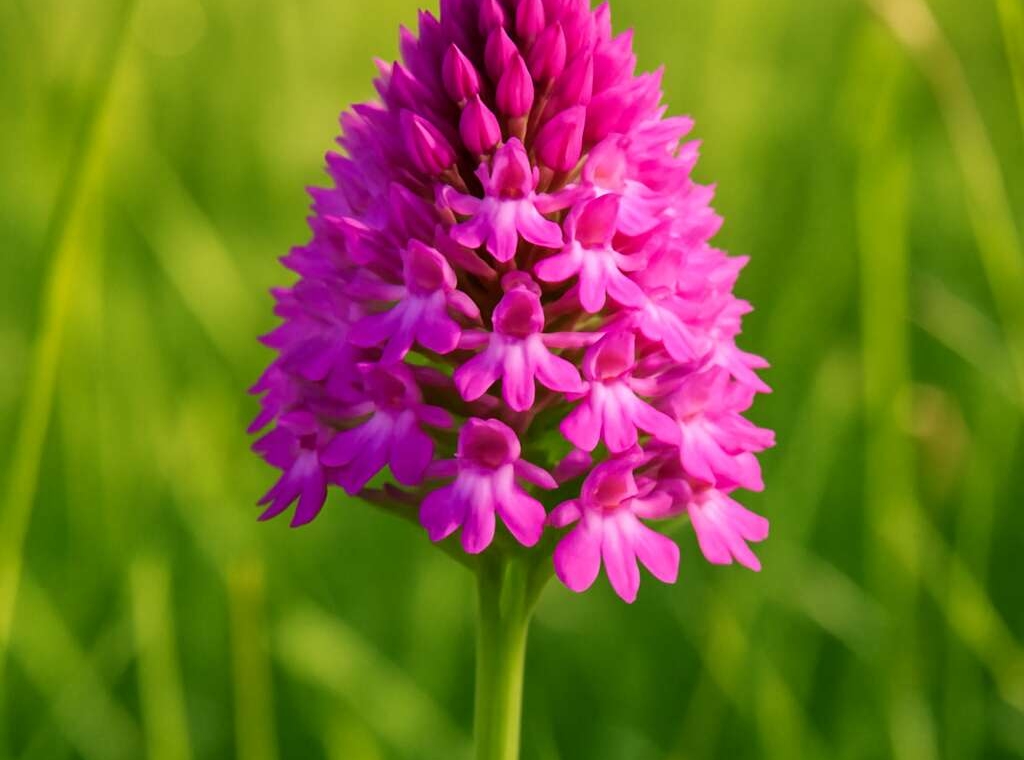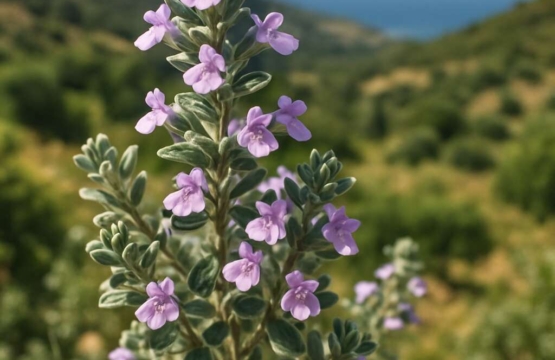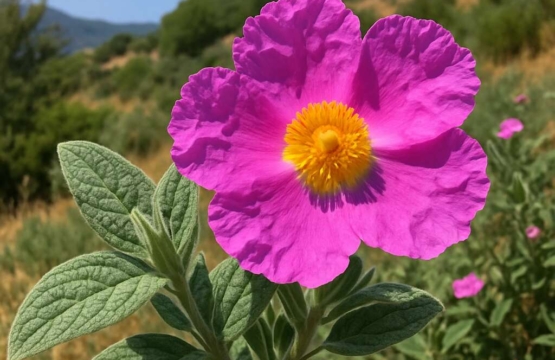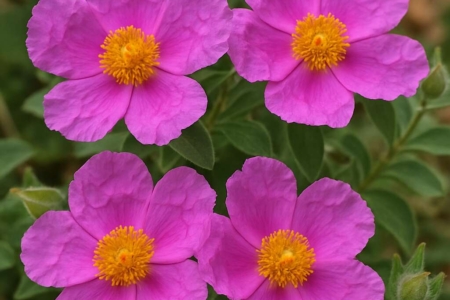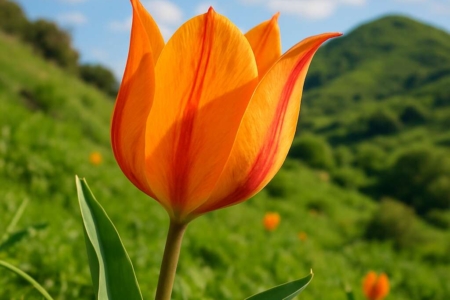Overview of the Pyramidal Orchid
Introduction to Pyramidal Orchid
The Pyramidal Orchid Anacamptis pyramidalis stands as a striking testament to nature’s intricate artistry. With its vibrant, conical inflorescence, this orchid commands attention in the wild landscapes of Cyprus. Its delicate petals, often tinged with shades of pink and purple, create a mesmerizing pyramid-like shape that seems almost otherworldly. This species thrives in well-drained, calcareous soils, often found in grasslands and open woodlands, where it subtly transforms the terrain into a living mosaic of color and form.
What makes the Pyramidal Orchid Anacamptis pyramidalis truly fascinating is its adaptability and resilience. During the flowering season, which peaks from late spring to early summer, the orchid’s unique structure attracts a variety of pollinators, playing a crucial role in local ecosystems. Its rarity in certain regions adds an element of mystery, sparking curiosity among botanists and enthusiasts alike. Exploring the habitats of this enchanting orchid reveals a hidden, vibrant world that continues to flourish despite environmental challenges.
Scientific Classification
Within the rich tapestry of botanical wonders, the Pyramidal Orchid Anacamptis pyramidalis stands out as a marvel of evolutionary artistry. Its scientific classification reveals a complex web of taxonomy that situates this enchanting species within the Orchidaceae family, a group renowned for its diverse and intricate forms. The genus Anacamptis, to which the Pyramidal Orchid belongs, encompasses a variety of terrestrial orchids distinguished by their resilience and captivating blossoms.
Specifically, the Pyramidal Orchid Anacamptis pyramidalis is classified as follows:
- Kingdom: Plantae
- Clade: Angiosperms
- Order: Asparagales
- Family: Orchidaceae
- Genus: Anacamptis
- Species: A. pyramidalis
This precise scientific hierarchy underscores its unique adaptations, from the conical flower spikes to the vibrant pink and purple hues that shimmer under the Mediterranean sun. The classification not only helps botanists trace its lineage but also illuminates the intricate relationships that this species shares with other orchids thriving in Cyprus’s diverse habitats. Exploring the scientific roots of the Pyramidal Orchid Anacamptis pyramidalis deepens our appreciation for its resilience and enduring charm.
Distinctive Features
The Pyramidal Orchid Anacamptis pyramidalis isn’t just a pretty face in the Mediterranean’s floral lineup; it’s a botanical marvel with a personality as vibrant as its colors. Standing tall with a conical, almost architectural flower spike, this orchid commands attention in Cyprus’s diverse habitats. Its distinctive floral structure resembles a tiny, pink pyramid—hence the name—making it a favorite among botanists and casual flower enthusiasts alike.
What truly sets the Pyramidal Orchid apart are its vivid hues—ranging from deep magenta to blush pink—that shimmer under the bright Cypriot sun. The densely packed flowers bloom in succession along the spike, creating a stunning visual spectacle that seems to defy the odds of survival in the wild. For those who appreciate natural resilience, the Pyramidal Orchid Anacamptis pyramidalis is a testament to the intricate artistry of evolution.
- The conical flower spike, packed with tightly clustered blossoms, is a signature feature.
- Bright pink and purple hues make it easily recognizable among Cyprus’s wildflowers.
- Its resilience in dry, rocky soils highlights its adaptive prowess.
Habitat and Distribution
Native Regions and Countries
The Pyramidal Orchid Anacamptis pyramidalis is a botanical marvel that seems to thrive on the very edges of civilization and wilderness alike. Its preferred habitat reads like a travel brochure for nature lovers—think sunny, well-drained calcareous grasslands, open slopes, and the occasional roadside verge that dares to host this flamboyant floral pyramid. In Cyprus, this orchid is a charming enigma, often spotted dotting the landscape where limestone rocks meet wildflower meadows, giving the terrain an extra splash of color and intrigue.
Its native regions span a surprising range across Europe and the Mediterranean basin, with Cyprus standing proudly among the prime locations for this botanical treasure. The distribution of Pyramidal Orchid Anacamptis pyramidalis reveals a pattern of adaptation to warm, temperate climates and alkaline soils, making it a true survivor in regions where other flora might hesitate. Here’s a quick rundown of its main countries of origin:
- Spain
- France
- Italy
- Greece
- Cyprus
So, whether it’s in the sun-drenched hills of Tuscany or the rugged limestone edges of Cyprus, the Pyramidal Orchid Anacamptis pyramidalis continues to enchant and perplex botanists and casual observers alike. Its distribution is a testament to its resilience and the delicate balance of Mediterranean ecosystems, making it a true icon of regional flora.
Preferred Environments
The Pyramidal Orchid Anacamptis pyramidalis is a striking testament to nature’s adaptability, flourishing predominantly in warm, sun-drenched environments that seem almost tailored for its flamboyant blooms. Its preferred habitat includes well-drained calcareous grasslands and open slopes, where the soil’s alkaline properties offer an ideal foundation for growth. These environments provide the perfect backdrop for its vibrant, pyramid-shaped flower clusters to stand out against the greenery, creating a visual spectacle that captivates botanists and enthusiasts alike.
In Cyprus, the Pyramidal Orchid Anacamptis pyramidalis often makes an appearance along rugged limestone edges and in wildflower meadows, where the landscape is kissed by Mediterranean sunlight. Its distribution across Europe and the Mediterranean basin underscores its resilience, thriving in regions with warm, temperate climates and well-drained soils. To better understand its habitat preferences, consider these key environments:
- Sunlit, calcareous grasslands
- Open slopes with rocky or limestone terrain
- Roadside verges that mimic its natural, well-drained conditions
The ability of the Pyramidal Orchid Anacamptis pyramidalis to adapt to such specific yet diverse habitats highlights its importance as a symbol of ecological resilience and biodiversity within Mediterranean ecosystems. Its presence continues to grace Cyprus and surrounding regions, a vivid reminder of the delicate balance between flora and environment that sustains regional natural beauty.
Altitude and Soil Preferences
The habitat of the Pyramidal Orchid Anacamptis pyramidalis is as diverse as it is specific. It thrives primarily in well-drained calcareous soils, which provide the alkaline environment essential for its growth. These orchids are often found on open slopes and grassy meadows, where sunlight penetrates freely, creating the ideal conditions for their vibrant blooms. In Cyprus, they frequently appear along rugged limestone edges and wildflower-dotted landscapes, showcasing their resilience in Mediterranean landscapes.
Altitude plays a significant role in their distribution. The Pyramidal Orchid Anacamptis pyramidalis is most abundant at low to moderate elevations, generally up to 600 meters above sea level. Its adaptability allows it to flourish across various terrains, from coastal areas to inland hills. The plant’s preference for specific soil types and altitudes underscores its sensitivity to environmental changes, making it a vital indicator of ecosystem health in regions like Cyprus.
- Well-drained calcareous soils
- Sunlit, open slopes and grasslands
- Low to moderate altitudes, typically up to 600 meters
This combination of habitat, altitude, and soil preference highlights the Pyramidal Orchid Anacamptis pyramidalis’s specialized niche, emphasizing its importance in maintaining biodiversity within Mediterranean ecosystems.
Physical Characteristics and Identification
Flower Structure and Color
The physical characteristics of the Pyramidal Orchid Anacamptis pyramidalis make it a striking sight in the wild. Its tall, slender stem can reach up to 50 centimeters, topped with densely packed flower spikes that resemble tiny pyramids—hence the name. The flowers are a vibrant shade of pink to purple, creating a vivid contrast against the greenery of the Mediterranean landscape. The flower structure is notably unique, with three-lobed petals and a broad labellum that serves as a landing pad for pollinators.
When it comes to identification, the Pyramidal Orchid Anacamptis pyramidalis stands out due to its distinctive flower arrangement and coloration. The flowers tend to cluster tightly in a pyramid shape, giving the plant its characteristic silhouette. The color can vary slightly, from bright pink to a more subdued mauve, but the overall pyramid-like formation and the shape of the flowers remain consistent across its habitat in Cyprus. Recognizing these features is key to distinguishing it from other orchids in the region.
Pyramidal Shape and Blooming Pattern
The Pyramidal Orchid Anacamptis pyramidalis is truly a marvel of botanical architecture. Its physical characteristics make it an unmistakable jewel of the Mediterranean flora, especially in Cyprus. Standing up to 50 centimeters tall, this orchid’s slender, elegant stem supports a dense cluster of tiny flowers that form a perfect pyramid—hence its name. The vibrant pink to purple blooms create a stunning visual contrast against the lush greenery, captivating anyone lucky enough to encounter it in the wild.
One of the most distinctive features of the Pyramidal Orchid Anacamptis pyramidalis is its unique bloom pattern. The flowers bloom in a tight, orderly arrangement that emphasizes the plant’s iconic pyramid shape. The blooms typically appear in a blooming pattern that peaks in late spring, offering a fleeting but spectacular display. Recognizing this orchid’s pyramidal shape and the shape of its three-lobed petals along with the broad labellum is key to identifying it among other regional orchids.
In the wild, the Pyramidal Orchid Anacamptis pyramidalis often grows in clusters, creating a mesmerizing ocean of pink and purple hues. Its blooming pattern—marked by dense, pyramid-shaped flower spikes—ensures it stands out even in diverse Mediterranean landscapes. This combination of physical characteristics and bloom structure makes the Pyramidal Orchid a true icon of botanical wonder in Cyprus and beyond.
Leaves and Stem Details
The physical characteristics of the Pyramidal Orchid Anacamptis pyramidalis reveal a creature of delicate yet commanding presence. Its slender, wiry stem often reaches up to 50 centimeters, standing like a silent sentinel amidst the Mediterranean flora. The stem’s subtle curvature hints at the orchid’s graceful resilience, supporting dense clusters of blooms that resemble miniature pyramids—each one a testament to nature’s intricate artistry.
Its leaves are typically narrow, lance-shaped, and arranged in a basal rosette, providing a lush green backdrop that accentuates the vibrant flowers. As the plant matures, a single, unbranched stem bears the weight of the dense flower spike, which tapers upward in a perfect geometric dance. The broad labellum and the three-lobed petals—distinctive features of the Pyramidal Orchid Anacamptis pyramidalis—serve as key identifiers, guiding keen eyes through a labyrinth of Mediterranean wilderness.
- The stem’s height and slenderness are crucial for recognition.
- The dense, pyramid-shaped flower spike creates a striking silhouette.
- The basal leaves form a rosette, providing contrast against the vibrant blooms.
In the shadowed corners of Cyprus’s wild landscapes, the Pyramidal Orchid Anacamptis pyramidalis emerges like a spectral flame—its physical form both fragile and resilient, a silent guardian of ancient botanical secrets. To truly understand this orchid’s allure, one must observe the interplay of its leaves and stem—elements that whisper tales of adaptation and silent endurance in the face of time.
Size and Growth Habit
The physical characteristics of the Pyramidal Orchid Anacamptis pyramidalis reveal a plant of captivating elegance and subtle strength. Its slender, wiry stem can reach up to 50 centimeters in height, standing tall among the Mediterranean flora of Cyprus. This delicate yet resilient structure supports dense clusters of vibrant flowers, each forming a miniature pyramid that commands visual attention.
Notably, the plant’s leaves are narrow, lance-shaped, and arranged in a basal rosette, creating a lush green contrast against the striking blooms. As the orchid matures, a single, unbranched stem bears a dense flower spike that tapers gracefully upward, showcasing the plant’s geometric beauty. The broad labellum and three-lobed petals are distinctive features, making the Pyramidal Orchid Anacamptis pyramidalis easy to identify in wild landscapes.
In terms of size and growth habit, this orchid typically reaches between 20 and 50 centimeters. Its growth pattern is upright, with the flower spike standing prominently above the foliage. The plant’s pyramidal shape and the dense arrangement of its flowers give it a unique silhouette—a true testament to the plant’s adaptation to Mediterranean environments. Keep an eye out for its slender stem and pyramid-shaped inflorescence, which are key identifiers for this remarkable orchid.
Blooming Period and Lifecycle
Flowering Season
The blooming period of the Pyramidal Orchid Anacamptis pyramidalis is a spectacular sight that typically unfolds from late spring to early summer, usually between May and July. During this time, the orchid’s vibrant, cone-shaped flower spikes burst into a riot of color—ranging from deep pink to purplish hues—that seem to glow against the Mediterranean landscape of Cyprus. The flowering season is relatively brief but intensely captivating, often lasting about four to six weeks, depending on local weather conditions.
This ephemeral window is crucial for the lifecycle of the Pyramidal Orchid Anacamptis pyramidalis. Its flowers attract a variety of pollinators, including bees and butterflies, which are essential for the plant’s reproduction. The plant’s lifecycle is intertwined with its blooming season; after flowering, the plant enters a period of dormancy, conserving energy for the next cycle. The flowering pattern of the Pyramidal Orchid is notably pyramidal, with the flowers opening in succession from the bottom to the top, creating a stunning visual ascent that mimics its name.
Growth Cycle and Pollination
The blooming period of the Pyramidal Orchid Anacamptis pyramidalis is a fleeting yet mesmerizing chapter in its lifecycle, typically gracing Cyprus with vibrant displays from late spring to early summer—roughly between May and July. During these precious weeks, the plant’s cone-shaped flower spikes explode in a symphony of deep pink and purple hues, creating a captivating spectacle against the Mediterranean landscape. This short-lived burst of color is essential for the orchid’s survival and reproductive success.
Following its spectacular bloom, the Pyramidal Orchid Anacamptis pyramidalis gracefully transitions into a dormant phase, conserving energy until the cycle begins anew. Its growth cycle is intricately tied to seasonal cues and environmental conditions, ensuring resilience amidst Cyprus’s diverse terrains. The flowering pattern—pyramidal with flowers opening successively from bottom to top—creates a visual ascent that truly embodies its name. This pattern not only enhances its aesthetic appeal but also optimizes pollination opportunities.
- Pollinators such as bees and butterflies are drawn irresistibly to the orchid’s vibrant blossoms, facilitating cross-pollination and genetic diversity.
- The plant’s lifecycle depends heavily on this pollination, which ensures the production of seed capsules that mature before the plant retreats into dormancy.
For the Pyramidal Orchid Anacamptis pyramidalis, each flowering season is a delicate chapter in its ongoing story of adaptation and survival—an ephemeral yet vital window that sustains its presence across Cyprus’s diverse ecosystems.
Longevity of the Blooms
The blooming period of the Pyramidal Orchid Anacamptis pyramidalis is a fleeting yet spectacular affair, much like catching a shooting star—rare and mesmerizing. Typically gracing Cyprus from late spring to early summer, roughly between May and July, this orchid’s vibrant display is brief but breathtaking. During these weeks, the Pyramidal Orchid transforms the landscape into a sea of deep pink and purple hues, creating a visual feast against the Mediterranean backdrop.
Once the show concludes, the Pyramidal Orchid Anacamptis pyramidalis gracefully slips into dormancy. Its lifecycle is finely tuned to seasonal cues, ensuring survival amid Cyprus’s diverse terrains. Interestingly, each flowering season is an ephemeral chapter—an elegant dance of adaptation and resilience—highlighting the orchid’s fleeting yet vital window for reproduction.
Its blooms follow a pyramidal pattern, opening successively from bottom to top, which not only accentuates its aesthetic appeal but also maximizes pollination chances. Pollinators such as bees and butterflies are irresistibly attracted to these vibrant blossoms, facilitating cross-pollination and ensuring the production of seed capsules. These capsules mature swiftly, allowing the orchid to conserve energy and prepare for the next cycle of life in Cyprus’s ever-changing environment.
In essence, each flowering season of the Pyramidal Orchid Anacamptis pyramidalis is a delicate yet vital act of survival, a fleeting spectacle that sustains its presence across Cyprus’s diverse ecosystems. The brevity of its blooms makes witnessing this natural marvel all the more precious—reminding us of nature’s artistry and resilience in the Mediterranean’s rugged landscape.
Ecological Importance and Pollinators
Pollination Strategies
The Pyramidal Orchid Anacamptis pyramidalis is more than a captivating bloom; it plays a vital role in the delicate web of Cyprus’s ecosystems. These orchids serve as crucial nectar sources for a variety of pollinators, supporting the health and diversity of local insect populations. Their vibrant, pyramid-shaped clusters act as a beacon for pollinating insects seeking nourishment in the wild, fostering a symbiotic dance that sustains both flora and fauna.
Pollination strategies of the Pyramidal Orchid Anacamptis pyramidalis are remarkably specialized. They rely predominantly on insect visitors such as bees, butterflies, and moths, which are attracted by the orchid’s vivid color and unique flower structure. Interestingly, the orchid’s nectar is often concealed, encouraging pollinators to brush against the reproductive organs, ensuring effective pollen transfer. This intricate strategy underscores the orchid’s evolutionary finesse—an exquisite example of nature’s ingenuity in promoting biodiversity.
- Pollinators include native bees, butterflies, and sometimes moths.
- The orchid’s flower structure encourages pollinators to contact pollen-producing parts.
- Pollination success depends on the synchronization between flower blooming and insect activity.
Role in the Ecosystem
The ecological significance of the Pyramidal Orchid Anacamptis pyramidalis extends far beyond its striking appearance. As a vital component of Cyprus’s natural habitats, it sustains a complex web of life by providing essential nectar sources for a diverse array of pollinators. These orchids are not just beautiful; they are keystone species that foster biodiversity and ecosystem resilience.
Pollinators such as native bees, butterflies, and moths are drawn to the vivid color and intricate structure of the Pyramidal Orchid Anacamptis pyramidalis. Their role is crucial: by transferring pollen during their visits, they facilitate genetic diversity and plant reproduction. The orchid’s concealed nectar encourages meticulous contact between pollinators and reproductive organs, ensuring effective pollination. This symbiotic relationship highlights the delicate balance of Cyprus’s ecosystems, where even the tiniest creatures play an outsized role in maintaining ecological harmony.
- Native bees actively forage on the orchids, supporting local pollinator populations.
- Butterflies and moths contribute during different times of day, extending pollination opportunities.
- The synchronization of blooming periods with insect activity boosts reproductive success for the Pyramidal Orchid Anacamptis pyramidalis.
Relationships with Specific Pollinators
The ecological importance of the Pyramidal Orchid Anacamptis pyramidalis cannot be overstated. These stunning orchids serve as essential nectar sources, supporting a vibrant community of pollinators in Cyprus’s diverse habitats. Their bright, vivid blooms attract native bees, butterflies, and moths, each playing a crucial role in maintaining the delicate balance of local ecosystems. As these insects forage, they inadvertently facilitate cross-pollination, ensuring the genetic vitality of the orchid and neighboring plant species.
Specific pollinators have evolved a close relationship with the Pyramidal Orchid Anacamptis pyramidalis. Native bees are particularly diligent visitors, supporting the resilience of pollinator populations while aiding in the orchid’s reproductive success. Meanwhile, butterflies and moths extend pollination opportunities across different times of the day, thanks to their varied activity periods. This symbiotic relationship underscores the importance of preserving natural habitats—where the orchid’s blooming period aligns perfectly with the activity peaks of its pollinators, creating a harmonious dance of life that sustains Cyprus’s rich biodiversity.
Cultivation and Conservation
Growing Pyramidal Orchids from Seeds
Growing Pyramidal Orchid Anacamptis pyramidalis from seeds is a journey into the heart of wildflower magic, especially in sun-kissed Cyprus landscapes where these orchids thrive. Unlike many cultivated plants, Pyramidal Orchid Anacamptis pyramidalis demands patience and a gentle touch, as its delicate seeds are dispersed by the wind, seeking out cracks and crevices in limestone-rich soils. The process begins with collecting mature seeds, which are then subjected to specific stratification methods to mimic natural winter conditions, encouraging germination. This meticulous approach allows enthusiasts to foster these enchanting orchids in their own gardens or natural reserves, helping preserve their natural habitat.
For successful cultivation, consider creating an environment that mimics the orchid’s native preferences—well-drained, calcareous soil and plenty of sunlight. Growing Pyramidal Orchid Anacamptis pyramidalis from seed not only cultivates beauty but also contributes to conservation efforts, as wild populations face threats from habitat loss. In fact, cultivating these orchids can help sustain their populations and ensure their vibrant blooms continue to grace Cyprus’ landscapes for generations to come.
Best Practices for Cultivation
Conservation of the Pyramidal Orchid Anacamptis pyramidalis requires more than just admiration; it demands diligent stewardship rooted in sustainable cultivation practices. In the sun-drenched landscapes of Cyprus, where these orchids have become emblematic of natural beauty, responsible actions can make a profound difference. Cultivators should prioritize creating environments that reflect their native habitat—calcareous, well-drained soils kissed by abundant sunlight. Such conditions foster healthy growth and vibrant blooms, ensuring these delicate orchids continue to enchant future generations.
To support the preservation of wild populations, adopting specific conservation best practices is essential. For example, avoiding overharvesting of seeds from wild plants helps maintain genetic diversity. Instead, propagating Pyramidal Orchid Anacamptis pyramidalis from cultivated sources can reduce pressure on natural populations. Implementing controlled disturbance methods, such as rotational grazing or habitat restoration, also aids in maintaining their delicate ecosystems.
When cultivating these orchids, consider the following:
- Use of limestone-rich, well-drained soil to mimic native conditions
- Ensuring ample sunlight exposure for optimal flowering
- Minimizing habitat disruption during planting or maintenance
By weaving these practices into conservation efforts, enthusiasts become guardians of the Pyramidal Orchid Anacamptis pyramidalis—an exquisite symbol of resilience and natural splendor in Cyprus’s landscapes. Each cultivated bloom becomes a testament to the delicate balance between human intervention and ecological harmony, ensuring that this captivating orchid continues to grace the Mediterranean’s sunlit meadows for years to come.
Conservation Status and Threats
The Pyramidal Orchid Anacamptis pyramidalis is a captivating symbol of Cyprus’s natural heritage, yet its survival hangs in a delicate balance. Despite its stunning appearance and widespread presence in Mediterranean grasslands, this orchid faces mounting threats from habitat loss and unsustainable collection. Its conservation status is currently vulnerable, emphasizing the urgent need for protective measures.
Habitat destruction, driven by urban expansion and agricultural intensification, continues to diminish wild populations of Pyramidal Orchid Anacamptis pyramidalis. Additionally, overharvesting from the wild exacerbates the decline, threatening genetic diversity. To safeguard these orchids for future generations, conservation efforts often involve habitat restoration and controlled management practices.
Implementing responsible cultivation practices is vital. For example, fostering the growth of Pyramidal Orchid Anacamptis pyramidalis in environments that replicate its native calcareous, well-drained soils can help bolster local populations. Moreover, promoting seed propagation from cultivated plants reduces pressure on wild populations—an essential step in preserving their ecological role.
Conservation Challenges and Strategies
- habitat fragmentation
- illegal collection and overharvesting
- invasive species competition
- climate change impacts
By understanding these threats and actively participating in habitat preservation and responsible cultivation, enthusiasts and conservationists become guardians of the Pyramidal Orchid Anacamptis pyramidalis. Protecting this exquisite species ensures that its resilience continues to grace Cyprus’s landscapes, inspiring awe in generations to come.
Efforts to Protect and Preserve
In the delicate dance of nature’s artistry, the Pyramidal Orchid Anacamptis pyramidalis stands as a luminous testament to the Mediterranean’s floral splendor. Its vibrant, cone-shaped flower spikes seem to reach for the sun in a resplendent display that captures the imagination. Yet, behind this captivating beauty lies an urgent call for stewardship—an imperative to protect and preserve this emblem of Cyprus’s natural heritage.
Conservation efforts are increasingly vital as habitat fragmentation, illegal collection, and invasive species threaten the survival of Pyramidal Orchid Anacamptis pyramidalis. To combat these pressures, dedicated initiatives focus on habitat restoration and establishing protected zones where these orchids can flourish undisturbed. Moreover, fostering responsible cultivation practices—such as seed propagation from cultivated plants—reduces reliance on wild populations and sustains genetic diversity.
Encouraging local communities and enthusiasts to participate in conservation efforts creates a ripple effect of awareness. For example, cultivating Pyramidal Orchid Anacamptis pyramidalis in managed environments that mimic its native calcareous, well-drained soils helps bolster existing populations. This approach, combined with vigilant monitoring of invasive species and climate change impacts, forms a vital tapestry of protection.
By nurturing these efforts, we transform from mere observers into guardians—champions of the Pyramidal Orchid Anacamptis pyramidalis’s fleeting yet enduring presence. Each bloom, a symbol of resilience, beckons us to preserve Cyprus’s ecological harmony and ensure that future generations can marvel at its pyramidal grace.
Comparison with Similar Orchids
Key Differences from Related Species
While the Pyramidal Orchid Anacamptis pyramidalis often steals the spotlight with its striking, conical flower clusters, it shares its habitat with a few orchid relatives that can cause some confusion among enthusiasts. One such contender is the Bee Orchid (Ophrys apifera), which mimics a buzzing bee, creating a convincing illusion that deters predators. Unlike the Pyramidal Orchid Anacamptis pyramidalis, which boasts dense, pyramidal flower heads in vivid shades of pink, the Bee Orchid’s flowers are more irregular and often resemble an insect paused mid-flight.
Another frequent comparison is with the Southern Marsh Orchid (Dactylorhiza praetermissa), which tends to prefer wetter environments and displays broader, more speckled leaves. The key difference from the Pyramidal Orchid Anacamptis pyramidalis lies in the flower arrangement and coloration—where the former’s blooms cluster tightly into a neat pyramid, the latter’s flowers are more uniformly arranged and tend to be a brighter hue.
- Flower shape and size
- Color intensity and patterning
- Growth habitat and preferred soil conditions
Understanding these subtle yet significant distinctions enhances recognition and appreciation of the delicate ballet of native orchids, especially the charismatic Pyramidal Orchid Anacamptis pyramidalis, which truly embodies the elegance of Cyprus’s floral tapestry.
Identification Tips
In the vibrant tapestry of Cyprus’s wildflowers, the Pyramidal Orchid Anacamptis pyramidalis stands out with its bold, conical clusters of vivid pink blooms. Yet, for the keen-eyed enthusiast, distinguishing this charismatic species from its orchid relatives can be both a delightful challenge and a rewarding pursuit. One notable contender is the Bee Orchid (Ophrys apifera), whose flowers mimic a buzzing bee to lure pollinators—an illusion that captivates many. Unlike the dense, pyramidal flower heads of the Pyramidal Orchid Anacamptis pyramidalis, the Bee Orchid’s blossoms are irregular and resemble an insect mid-flight, creating a striking contrast.
Another close comparison is the Southern Marsh Orchid (Dactylorhiza praetermissa). Preferring wetter, marshy habitats, it features broader, more speckled leaves, and its blossoms form looser clusters. The key to telling these orchids apart lies in their flower shape, color intensity, and growth environment. The Pyramidal Orchid Anacamptis pyramidalis’s blooms are tightly packed and uniformly bright pink, making it a true jewel of Cyprus’s floral landscape. Recognizing these subtle distinctions enriches appreciation for the delicate ballet of native orchids that grace the island’s wild spaces.
Interesting Facts and Cultural Significance
Historical Uses and Cultural Meaning
The Pyramidal Orchid Anacamptis pyramidalis isn’t just a pretty face; it holds fascinating cultural and ecological significance. In regions like Cyprus, this orchid is often seen as a symbol of natural beauty untouched by modern development. Its vibrant pink blossoms, arranged in a striking pyramidal shape, have inspired local folklore and botanical art for centuries.
Historically, the Pyramidal Orchid Anacamptis pyramidalis was used in traditional medicine, believed to possess healing properties for various ailments. Though modern science has yet to confirm these claims, the orchid’s historical uses highlight its importance in cultural practices. The flowers also served as a marker of seasonal change, signaling the arrival of spring when they bloom in abundance.
Interestingly, the Pyramidal Orchid Anacamptis pyramidalis plays a vital role in supporting pollinator populations. Its unique flower structure attracts specific pollinators, such as bees and butterflies, reinforcing its ecological value. This relationship underscores the orchid’s place in the broader ecosystem, especially in the diverse habitats of Cyprus and surrounding regions.
Mythology and Symbolism
In the shadowed corners of Cyprus’s rugged landscapes, the Pyramidal Orchid Anacamptis pyramidalis emerges like a delicate specter from the earth, its vibrant pink blooms whispering secrets of ancient myths. This orchid, with its unmistakable pyramidal cluster of flowers, has long captivated those who seek beauty tinged with mystery. Legend whispers that the Pyramidal Orchid Anacamptis pyramidalis symbolizes the ascent of the soul—its pointed blooms reaching toward the heavens, echoing mankind’s eternal yearning for transcendence.
Throughout history, this enchanting orchid has been intertwined with folklore and symbolism. In some tales, it was believed to ward off evil spirits, its striking silhouette standing as a guardian in sacred groves. Its fleeting blooms serve as a reminder of life’s transient beauty, a fleeting glimpse into nature’s clandestine artistry. The Pyramidal Orchid Anacamptis pyramidalis is not merely a flower but a living emblem of transformation, resilience, and the enduring allure of the mythical landscape of Cyprus.
Fun Facts
Among Cyprus’s wildflower treasures, the Pyramidal Orchid Anacamptis pyramidalis stands out as a captivating symbol of natural elegance. Its vibrant pink blooms, arranged in a striking pyramid shape, not only delight the eye but also harbor intriguing secrets about the island’s rich biodiversity. Interestingly, this orchid is a magnet for pollinators, especially certain species of bees and butterflies, which are drawn to its vivid coloration and unique floral structure. These interactions highlight the orchid’s vital role in maintaining the delicate balance of Cyprus’s ecosystem.
In local folklore, the Pyramidal Orchid Anacamptis pyramidalis is believed to embody spiritual ascent, with its upward-reaching blooms symbolizing mankind’s quest for transcendence. Its fleeting appearance during the summer months echoes the transient beauty of life itself—an ephemeral masterpiece crafted by nature’s hand. This orchid’s resilience and adaptability have made it a favorite among botanists and nature enthusiasts alike, emphasizing its cultural and ecological significance in Cypriot landscapes.
